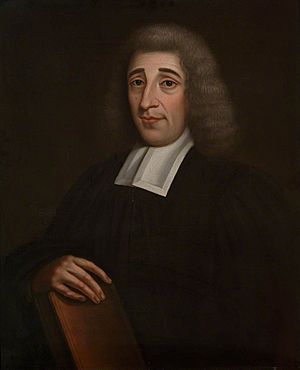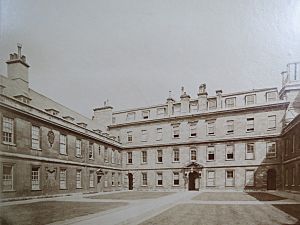James Burrough (architect) facts for kids

Sir James Burrough (born in 1691, died in 1764) was a smart English scholar and a talented amateur architect. He was in charge of Gonville and Caius College at Cambridge University. He helped design or update many buildings there, giving them a popular Classical look.
Life of Sir James Burrough
James Burrough was born on September 1, 1691, in Bury St. Edmunds, England. His father was also named James Burrough and was a doctor. Young James went to grammar school in Bury for eight years.
In 1708, he went to Gonville and Caius College, Cambridge. He earned his first degree (B.A.) in 1711 and a master's degree (M.A.) in 1716. He became an esquire bedell in 1727, which was a university official role, and he held this job until 1749.
Later, he became a Fellow of his college in 1738. In 1754, he was chosen to be the Master of Gonville and Caius College. He stayed in this important role until he passed away on August 7, 1764. He also served as the Vice-Chancellor of the university in 1759.
Sir James was a member of the Society of Antiquaries, a group that studies old things. He also collected pictures, prints, and medals. In 1759, he was made a knight by the Duke of Newcastle, who was in charge of the university. Sir James Burrough was buried in the chapel of Caius College.
Architectural Work at Cambridge

Sir James Burrough was well-known at Cambridge University for his skills in architecture. Even though he wasn't a full-time professional architect, he helped bring the popular Classical style to many university buildings. Sometimes, he even received a fee for his work, like for his designs at Peterhouse.
In 1721, he joined a group planning to build the new Senate House. He submitted a design, and another architect, James Gibbs, helped improve it. Burrough likely gave ideas for the overall style and layout of this important building.
Sir James was definitely responsible for several key projects:
- The dome-like structure over the combination room at Caius College (1728).
- Changing the hall of Queens' College into an Italian-style room (1732).
- Making the chapel at Emmanuel College more beautiful (1735).
- Designing a new building at Peterhouse (1736).
- Updating the outside of the quadrangle at Trinity Hall with stone in a Classical style (1742–1745). This process, called "refacing," changed the look of older medieval college courtyards.
He also designed the doctors' gallery in Great St. Mary's Church. He updated the Gonville Court at his own college, Caius, in 1751, and did similar work at Peterhouse in 1754. His last project was a new chapel for Clare Hall (1763), which was finished by his student, James Essex, after Burrough's death.
Sir James also designed the dining room at Sidney Sussex College. This elegant room helped attract more students and Fellows to the college. He was often asked for advice on other building projects in Cambridge and even helped with plans for a new bridge in Wisbech in 1757.
Sources
![]() This article incorporates text from a publication now in the public domain: Clark, John Willis (1886). "Burrough, James (1691-1764)". Dictionary of National Biography 07. Ed. Leslie Stephen. London: Smith, Elder & Co.
This article incorporates text from a publication now in the public domain: Clark, John Willis (1886). "Burrough, James (1691-1764)". Dictionary of National Biography 07. Ed. Leslie Stephen. London: Smith, Elder & Co.
| Academic offices | ||
|---|---|---|
| Preceded by Sir Thomas Gooch |
Master of Gonville and Caius College, University of Cambridge 1754-1764 |
Succeeded by John Smith |
| Academic offices | ||
| Preceded by ' |
Esquire Bedell 1727-1749 |
Succeeded by |

